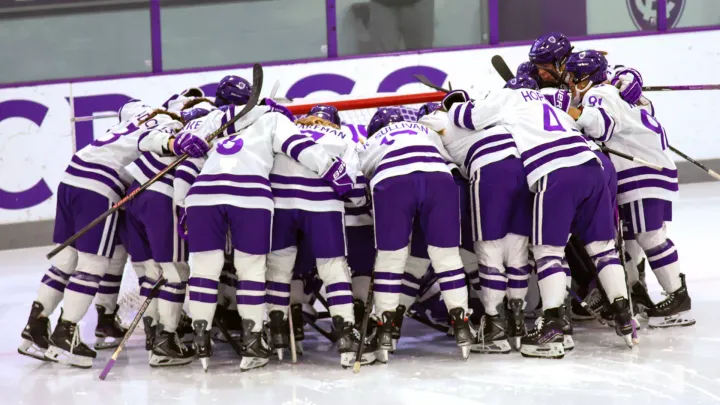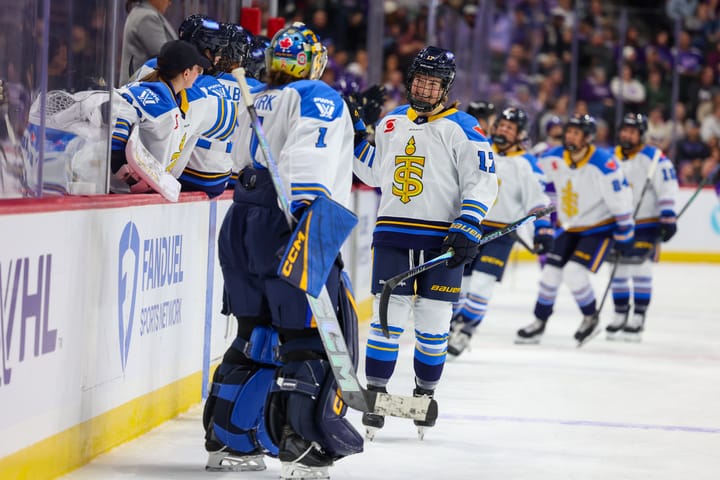Topsy Turvy in Hockey East: How Special Teams Are Changing the Game
The Power Play and Penalty Kill can be integral or detrimental to a team over the course of a season, and HEA is showing that in real time in 2025-26.

It’s no secret that special teams can shape a game, a season, a team. When they’re performing well, it helps propel a team to incredible heights. See Wisconsin, who was atop of the standings in both power play success and penalty kill proficiency last season and didn’t do much besides win the national title. No big deal, right?
But when special teams are not performing, it becomes part of a larger story, and it’s harder to break out of a tough stretch when things continue to devolve than one might think. No, it’s not the only reason for a team’s struggles or a team's success, but when there’s an extreme drop off — or extreme jump — from one year to the next, it can create a ripple effect for an entire year.
So, when I looked at Hockey East and saw BU near the bottom of the standings and Holy Cross near the top, I decided to look deeper into how the special teams are dictating each team's seasons. Unsurprisingly, both the power play and the penalty kill are playing into how 2025-26 is going so far for both teams.
Let's start with Boston University. This is a team that last year shocked a lot of people with just how solid they became. The Terriers went 24-12-2, finished second in the standings during the regular season, and wound up winning the conference tournament in March. Almost nobody thought the team would finish where they did, besides themselves. And to most, it seemed as though the team would follow that up with another successful season in 2025-26, starting right from the jump.
Checking in as the highest ranked @hockey_east team in the @USCHO and @usahockey polls!#GoBU pic.twitter.com/7LyDFKL79Z
— BU Women's Hockey (@TerrierWHockey) September 16, 2025
Instead, with three games left before the December break, the Terriers are just 3-10-1. They currently sit in sixth in Hockey East with 11 points in nine games, have a -18 goal differential, and have found themselves in the basement of the NPI rankings (34th out of 45 teams).
So what exactly has happened to the Terriers? Well, first and foremost they lost three of their top defenders — all of whom spent at least four years in the red and white — and starter Callie Shanahan to graduation. Replacing the caliber of those players was never going to be easy, and that’s become evident through the first two months of the season.
But what I’d argue is that it’s not just the departures that have caused a dip for BU. The struggles on the special teams units are just as impactful to the teams performance as the losses on the back end.
A season ago, BU had the best penalty kill in Hockey East (and second best in the NCAA), after they finished the year with a 89.3% success rate while down a skater. On 121 penalties taken, the Terriers surrendered 13 goals against, and even scored a conference-high four while shorthanded as well.
Now this year, it’s a completely different story. On 55 penalties taken, BU has already conceded 11 goals, and their 80% success rate is sixth best of the 10 teams, and 31st in the nation.
Although I don’t expect them to stay at exactly these numbers, if we do some math here: 34 games in a season (minimum), times 3.9 penalties against per game (the team’s current average), is 132.6 (I highly doubt that gets that high). Twenty percent (the Terriers' current PK %) of 132.6 is 26.5, or 27 if we’re rounding to the closest whole number.
That’s more than double the amount of PPGs against from one season to the next, if the current stats hold.
The struggles on the PK aren’t all either, as their power play has dropped from the fourth best in HEA (16.8%), to dead last: they’re scoring on just 5.6% of their drawn penalties.
Tamara Giaquinto to Montreal in the sixth round. Power-play weapon with her one-timer. pic.twitter.com/I5Oma2XEW2
— Kyle Cushman (@Kyle_Cush) June 25, 2025
Of the three defenders BU lost, losing Tamara Giaquinto was always going to have an impact. Especially since she scored six of BU’s power play goals last season, double the amount of anyone else on the Terriers. And if we go deeper into the scoring breakdown, of the 19 PPGs scored by BU last year, 12 came off the stick of players who have since graduated.
It’s not as though the Terriers aren’t getting calls this year either. In fact, their 54 power play opportunities is third best in the conference behind Northeastern and Holy Cross. However, the difference for the Terriers is that both teams ahead of them have scored double digits on the PP already, and they very much haven’t.
Which leads me to talking about Holy Cross — who, if you haven’t noticed, are currently third in the conference with 15 points (11-5-1 overall record). I said before the season began that this was the year HC would take a step, and so far they have.
One of the reasons for that step is the increase in production on the power play, which finished 2024-25 as the worst in the conference at 9.3%. The Crusaders scored 11 times on the advantage last year (118 opportunities), led by Emily Crovo and Alexia Moreau — both of whom returned for another year in Worcester. Now, on 57 attempts so far, HC already has 10 goals, or a 17.5% conversion rate.
Cantelon puts us up 2-1!#GoCrossGo pic.twitter.com/f0Ti1OV9B1
— Holy Cross Women's Hockey (@HCrossWHockey) November 15, 2025
More math! If the Crusaders continue to get 3.4 power plays per game, multiply that by 34 games for 115.6 power play opportunities. If their conversion rate stays the same, that is 20.23 goals, aka 20 power play goals throughout the season.
What I will say against Holy Cross is that they’ve had the advantage of playing some of the weaker penalty kills in not just the conference, but also the nation. Of the eight teams the Crusaders have scored against while on the power play, only two have a PK rate over 80%. The remaining teams have had some struggles on the PK, which the Crusaders are taking advantage of — though this is something HC didn’t always do last year.
BU on the other hand has played against some of the best penalty kills in the country, including Northeastern (No. 1 in the nation, 95.2%), Maine (No. 2, 92.3%) Brown (No. 10, 88.2%), and Boston College (No. 11, 88%). Holy Cross has only faced Maine on this list, and was able to convert on one of their five power play opportunities over two games. Additionally, the Terriers will next take on the current No. 3 best penalty kill team in their next game on Dec. 2nd.
Oh, did I not mention that these two teams play each other early next week? And that Holy Cross has the third best PK in the country? My mistake.

Yes, you’re reading that correctly. The Crusaders are currently third in PK success in the NCAA as a whole, with a 92.2% success rate, just 0.1% behind Maine for second-best. Last year, HC didn’t have a bad PK by any measure of the word, as their 84.4% was middle of the pack nationally and in conference.
However, combined the power play that’s taken a major step, and the PK that’s improving upon an already solid unit, and it in part explains how the Crusaders are seeing an uptick in production this season.
Do I think these numbers will last for both teams? Absolutely not. It’s still November for crying out loud, there’s still so much time left for things to even out. Plus, the best way to improve upon things is to keep working on them, and if BU switches things up on the power play I’d be astounded if things don’t pick up.
Seeing these teams play one another next week is intriguing for a variety of reasons, but mainly because I want to see how things square away before the December break. Getting things rolling heading into the last weekend of 2025 could be huge for BU’s momentum following the Holidays. Meanwhile for the Crusaders, continuing to push puts them in a great position for the second half of the year, especially if they continue to perform near the top of the Hockey East standings.
It’s also just fun to see how the Turnpike Trophy goes, especially after some entertaining games between these teams the last few years. It’ll be interesting to watch on Tuesday, and it could have some real repercussions in the conference standings moving forward.





Comments ()